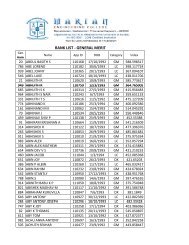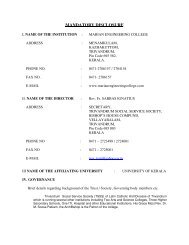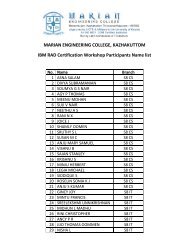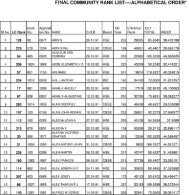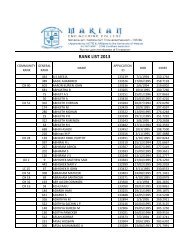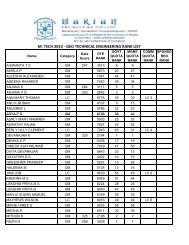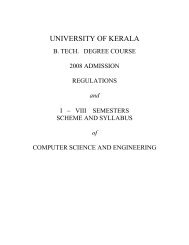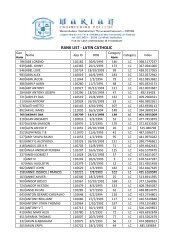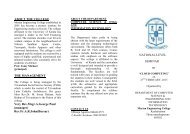UNIVERSITY OF KERALA - College of Engineering, Trivandrum
UNIVERSITY OF KERALA - College of Engineering, Trivandrum
UNIVERSITY OF KERALA - College of Engineering, Trivandrum
Create successful ePaper yourself
Turn your PDF publications into a flip-book with our unique Google optimized e-Paper software.
08 . 306 ENGINEERING GEOLOGY<br />
L T P/D Cr<br />
Module I<br />
3 1 0 4<br />
Scope <strong>of</strong> Geology in Civil <strong>Engineering</strong> and scope <strong>of</strong> Geological <strong>Engineering</strong> Subdivisions <strong>of</strong> Geology.<br />
Exogenous and Endogenous geological processes and their relevance in civil engg. Interior <strong>of</strong> the Earth.<br />
Basic concepts <strong>of</strong> Continental drift hypothesis and Plate tectonics theory.<br />
Soil genesis-Weathering : Factors , agents , types , products and engineering significance <strong>of</strong> weathering.<br />
Soil pr<strong>of</strong>ile , Geologic classifications <strong>of</strong> soils, Soil erosion and Soil conservation measures.<br />
Rivers : Erosion , transportation and deposition. Major Erosional and Depositional Landforms<br />
Oceans : Coastal landforms , Marine erosion and Coastal protection.<br />
geological hazards: Landslides – Types , causes and prevention ; Landslides <strong>of</strong> Kerala Earthquakes –<br />
Terminology and classifications , Safety factor<br />
Module II<br />
Definition and physical properties <strong>of</strong> minerals.<br />
Physical properties and Chemical composition <strong>of</strong> : Quartz , Feldspars (Orthoclase , microcline and plagioclase) ,<br />
Micas ( Biotite and Muscovite) , Amphibole (Hornblende only) , Pyroxenes ( Augite and Hypersthene) , Olivine<br />
, Sillimanite , Garnet , Talc , Gypsum , Calcite , Dolomite , Clay minerals ( Kaolinite only )<br />
Genetic divisions <strong>of</strong> rocks , rock cycle.<br />
Brief account <strong>of</strong> texture , structure and classifications <strong>of</strong> igneous , sedimentary and metamorphic rocks. Brief<br />
study <strong>of</strong> Granite , Gabbro , Dolerite , Basalt , Pegmatite, Sandstone , Limestone , Shale , Granulite , Gneiss ,<br />
Schist , Slate , Marble and Quartzite . rock types <strong>of</strong> Kerala . <strong>Engineering</strong> properties <strong>of</strong> rocks used as site rocks ,<br />
building stones and aggregates<br />
Module III<br />
Attitude <strong>of</strong> rocks and Geological structures – strike and dip , Brunton compass. Terminology ,classification and<br />
engineering significance <strong>of</strong> Folds , Faults , Joints and Unconformities.<br />
Major geological factors to be considered in the construction <strong>of</strong> Dams and Reservoirs , Tunnels , Building<br />
foundations , Bridges and Transportation routes. Hydrogeology-occurrence <strong>of</strong> ground water-types <strong>of</strong> aquifers.<br />
Geophysics: Electrical resistivity seismic refraction methods.<br />
Geoinformatics-Basic principles <strong>of</strong> Remote sensing , Geographic Information Systems and Global Positioning<br />
Systems.<br />
References:<br />
1 Anji Reddy ( 2001 ), Text book <strong>of</strong> Remote sensing and Geographic Information Systems BS Publications.<br />
2. Chenna Kesavulu ( 1993) Text book <strong>of</strong> <strong>Engineering</strong> Geology , Macmillan , India .<br />
3. Parbin Singh ( 2001 ) <strong>Engineering</strong> and General Geology, Kataria and Sons.<br />
4. Venkat Reddy ( 1995) <strong>Engineering</strong> Geology for Civil Engineers - Oxford IBH.<br />
5. Krynine and Judd (2001), Principles <strong>of</strong> <strong>Engineering</strong> Geology and Geotechnics , Cbs Publishers<br />
6. KVGK Gokhale Principles <strong>of</strong> <strong>Engineering</strong> Geology, B S Publications (2005)<br />
Question Paper: Duration: 3 hours<br />
The question paper consists <strong>of</strong> Part A and Part B.<br />
Part A is for 40 marks. There will be 8 compulsory short answer questions <strong>of</strong> 5 marks each covering entire<br />
syllabus.<br />
Part B is for 60 marks. There will be two questions from each module. The candidate has to answer one<br />
question <strong>of</strong> 20 marks from each module.<br />
Note: No charts, tables, codes are permitted in the Examination hall .If necessary relevant data shall be given<br />
along with the question paper by the question paper setter.<br />
33



